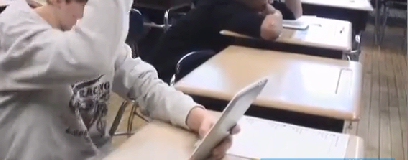
I once told someone that when I got my Kindle, I’d re-discovered the joy of reading. It was almost like when I’d first learned how to read books for the first time as a small child. But what happens when our schools try teaching a child how to read using a Kindle? And what happens if the teachers are using Kindles for an entire classroom full of fifth graders?
“We have several quotes from them, and it always ends with ‘And now I love reading,'” the fifth grade teacher told a local news crew.
In upstate New York, just a few miles from Lake Ontario, Ms. Sayles has her students reading on eight different Kindles, and she thinks it’s working great. “They didn’t use to love reading class,” she explains to the reporters — before a cute fifth grade girl tells them the same thing. “I like how the Kindle makes reading more fun,” says Madelyn, “and it’s making me look forward to reading and school. It makes it more interesting…”
There’s eight Kindles that they’re sharing in the classroom, and because they’re all registered to one account, each ebook can appear on six different Kindles. That will ultimately save money for the school district, the teacher believes, especially since she’s sharing all the Kindles and ebooks with a special education teacher. The school district has a foundation which awarded a grant to the two teachers last June. They’re using the money to purchase the Kindles — and they’re finding it also has other advantages.
It seems to work as equalizer for the students’ books, since with printed books, they might have felt intimidated by the book’s weight and the large number of printed pages. (“Usually I don’t go near big books,” young Madelyn explained. “But you can’t really tell, and it goes by faster!”) Struggling readers might also have been embarrassed to be seen with the skinnier remedial books, but on the Kindle, no one can tell the difference. And when the students come to a word that they don’t understand, they can look-up the word in the Kindle’s built-in dictionary! “It’s great for vocabulary,” says Ms. Sayles.
Some students even use the text-to-speech feature as they follow along in the text. And if there’s a student with a vision problem, the Kindle’s font sized can be increased. “The biggest thing is that it’s gotten kids excited about reading,” says Ms. Sayles, adding another prediction. “This is the technology that’s going to be in their future. So why not start them at this age.”
The fifth grade teacher also made another good point: kids today already seem to be living in a “technology screen world.” So I had to wonder if she had mixed feelings about giving the kids yet another screen to focus on when they’re already saturated in that screen-oriented lifestyle. “I’m not sure if it will move them away from it,” Ms. Sayles told the newspaper, “but I think if it can get them to read then it’s OK….
“If we can get them excited about reading at this age, it creates a lifelong reader.”